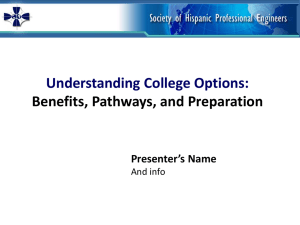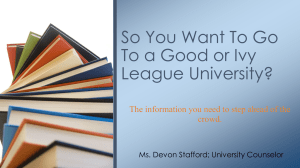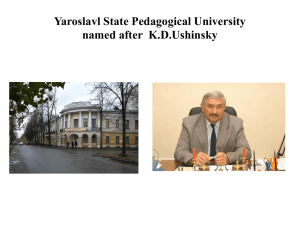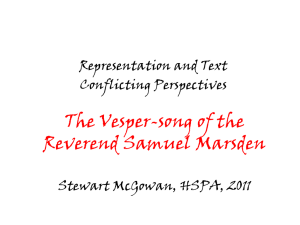The Secularization of American Higher Education
advertisement
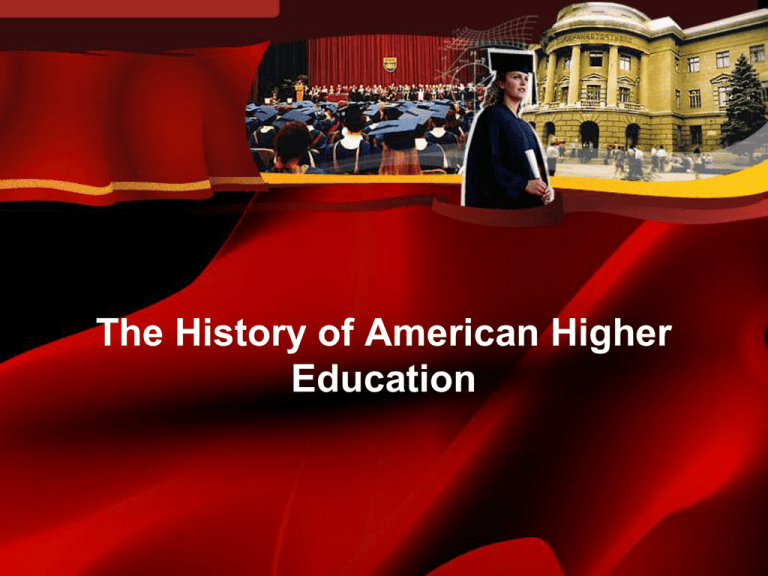
The History of American Higher Education Introduction • • • • • American colleges Sectarianism Transition to universities Secularism Conclusions Primary Source The Soul of the American University: From Protestant Establishment to Established Nonbelief George M. Marsden (Oxford University Press, 1994) American Colleges American Colleges • The first American college – Harvard College (1636) – Congregationalist – Primarily Cambridge University (Emmanuel College) professors found Harvard. Some Oxford professors served on the faculty, too. – Founded with the Puritan belief that all vocations are sacred • Half of the first graduates became clergy • Other half pursued other professions with a view that this was their Christian mission – Motto – Christo et Ecclesiae American Colleges • Yale College (1701) – Anglican (in the midst of a Calvinist colony) – Founded by Connecticut clergy reacting to perceived decline of Christian orthodoxy at Harvard – Became a focal point of the 1st Great Awakening American Colleges • Other Ivy League colleges – College of New Jersey (1746) – Princeton • Presbyterian – King’s College (1754) – Columbia • Anglican – College of Philadelphia (1755) – Pennsylvania • Presbyterian – Brown College (1764) • Baptist – Dartmouth College (1769) • Congregationalist American Colleges • Other prominent American colleges – Queen’s College (1766) – Rutgers University • Dutch Reformed – College of William and Mary (1693) • Anglican – Free School (1743) – University of Delaware • Presbyterian – College of California (1860) – UC Berkeley • Presbyterian and Congregationalist American Colleges – Newbury Biblical Institute (1839) – Boston University • Methodist – Boston College (1863) • Catholic – St. John’s College (1841) – Fordham University • Catholic – University of Chicago (1890) • Baptist American Colleges • Land Grant Colleges – 1862 – Morrill Act granted a portion of land in each state to found a technical or agricultural school • University of Illinois • Georgia Institute of Technology • Texas Agricultural and Mechanical • Mississippi State University • Pennsylvania State University • University of Kentucky Sectarianism Sectarianism “The ‘ambition and tyranny’ of the Presbyterians… ‘would tolerate no rival if they had power’…Presbyterians, Jefferson was convinced, yearned to reinstitute a Protestant inquisition that would...‘exterminate all heretics to Calvinistic Creed’ ” Marsden, 68. Sectarianism • Two kinds of sectarianism in colleges – Presbyterian • Emphasized orthodoxy and creeds – Jeffersonian • Emphasized freedom from religious tests “Liberal unitarian Christian moralists were not any less a religious party than were conservative Presbyterians” Marsden, 76. Sectarianism • American colleges were sectarian – Each belonged to a particular Christian denomination – Each had a particular statement of faith – Students and especially the faculty were required to adhere to that statement of faith – These were early speech codes Sectarianism “In letters to [Yale College] founders, the Mathers (Increase and his son, Cotton)…suggested that they follow a continental rather than English model for Reformed colleges by requiring faculty to subscribe to the confessions of the church as a guarantee of orthodoxy” Marsden, 52. Sectarianism • As more American professors were European educated, they resisted these statements of faith – The professors were more open minded, and saw fewer necessary distinctions between denominations – They viewed sectarian statements as divisive – Many professors, frankly, no longer believed them Transition to Universities Transition to Universities • Expanding industrialization • Increasing demand for research universities – Scientific advancement – Meet the needs of industry • The Gentleman Scholar – People not pursuing specific professions began studying at colleges – The colleges could not meet the demand for undergraduate much less graduate education Transition to Universities • Professors and scholars began going to Europe for post-graduate education – Master’s and doctoral degrees were unavailable in America – If colleges were to become universities, faculty with post-graduate degrees were necessary Transition to Universities • Scholars and professors returned from Europe with primarily German ideals – Divine mission of the university to pass on knowledge from one generation to the next – Growth and development of knowledge and human civilization • Darwinism • Literary criticism – Christians defended these ideas as the latest advancements Transition to Universities • Change from English to German style of education – British tradition emphasized • empiricism and common sense • science • mechanism • the divine in heaven – German tradition emphasized • a romantic nation of scholars • science in the humanities • growth and development • the divine in humanity Transition to Universities • Universities should not be church, but state run “Educational reform should come from the state. German universities were controlled by the various German states” Marsden, 107. • Differing educational models – English – research and writing – German – classes and examinations • From 1852-1863 University of Michigan under chancellor Henry P. Tappan became the first institution to adopt a German model Transition to Universities • The German “method” included rigorous empiricism that emphasized science and not theology • Methodological secularization “One of the major dynamics of complex modern societies arises from the principle that many tasks are done most efficiently by isolating and objectifying them…In effect, one creates a mechanism for addressing the issue and applies this to a practical problem. Religious considerations play little if any role in the mechanism itself” Marsden, 156. Transition to Universities • Christians defended methodological secularization, because “ ‘religion…claims to interpret the word of God, and science to reveal the laws of God’ ” Marsden, 157. • Modern universities were founded on scientific empiricism that resulted in naturalism when God was removed from knowledge and consequently the classroom Transition to Universities • Christian theology was taught less and less – Higher criticism – It was harder for modern professors to justify sectarian statements of faith – Theology reduced to moral philosophy – the Jeffersonian ideal • For a few decades it was taught in classrooms • Later it was removed from classrooms and relegated to the Student Life office Transition to Universities – Teaching theology was replaced with teaching virtue • What defines what is virtuous? – Society? – Personal reflection? – God? • Any focus other than God leads ultimately to humanism and naturalism – In the end senior courses in moral philosophy which integrated collegiate studies with a Christian worldview were cast off Transition to Universities “By purporting to discover a universal set of rationally based moral principles, the new ethics was presuming to do for core elements in human experience what the new physics did for the periphery…It was hence more difficult to see that this project, at least when it was conducted by pious confessing Christians, also had the potential for making Christian revelation superfluous” Marsden, 52. Transition to Universities • American colleges began adding graduate schools and became universities • Established institutions began drifting away from sectarianism, and some newly established universities, like Cornell, deliberately emphasized nonsectarianism Secularization Secularization • A weakened traditional Christian presence in the university, a broadly accepted liberal Protestant remnant, and a new passion for nonsectarianism led to secularization • Christians were powerless to stop it – Many had abandoned the university – The church had bought Kantian dualism • Real world – five senses, science – knowledge • Private world – God, morality – no knowledge Secularization • The process of secularization began with the labor union movement – Professors tended to be more sympathetic to unionization – American Association of University Professors (1915) • Faculty tenure • Academic freedom Secularization • AAUP members were appointed to accreditation committees – All colleges and universities have there curriculums reviewed and reaccredited every 5-10 years – AAUP members had tenure and academic freedom added to accreditation requirements Secularization • The result of reaccreditation – Most colleges couldn’t or wouldn’t reconcile the requirement of academic freedom with particular statements of faith – Most institutions consequently cut ties with the denominations that gave them birth Secularization • Foundations, such as the Carnegie Endowment, began offering large grants for nonsectarian institutions of higher learning – Some denominations could not give as much money to their schools as Carnegie promised – This encouraged many other colleges and universities who remained Christian to jettison their religious affiliations for the promise of major foundation funding Secularization • The fruit of tenure – Sixties radicals could not change the establishment from without – They put on suits and went to graduate school – They now hold most tenured faculty positions in universities. Secularization • The fruit of academic freedom – Most 20th century professors were steeped in Nietzschean nihilism – If the individual should be free to do anything they wish, then statements of faith are ridiculous – Academic freedom promoted the abandonment of statements of faith Secularization • Nature abhors a vacuum – The abandonment of statements of faith left a spiritual and ideological vacuum – Without Christian influence, universities rapidly gravitated to political correctness – This is the new orthodoxy in secular universities, with their own statements of faith – Speech codes are now hidden in nondiscrimination statements Conclusions Conclusions • The university is still often fighting a Christian establishment that no longer exists – They are living in the past – Christians no longer rule – The new orthodoxy tests restrict freedom for non-naturalistic ideas Conclusions • Beware of campus Nazis who demand loyalty to the naturalistic hegemony – Nazism stifles any dissent or differing views • Political Nazis like Code Pink or radical environmental groups • Moral Nazis like militant homosexuals, feminists, hedonists, etc. Conclusions • Finding a voice – Postmodern sentiments permit a Christian voice • Don’t buy postmodernism • Postmodernism is just as exclusively naturalistic as modernism – Appeal to academic freedom in order to bring a Christian viewpoint back to the classroom and the laboratory Conclusions – Appeal to tolerance and diversity as justification for religious viewpoints – Appeal to social justice as grounds for including Christian ideas – Do not be cowed by church and state arguments, especially in state universities – Don’t be afraid to defend the Truth Conclusions – Science itself is now viewed as “sectarian” "Few academics [believe] in neutral objective science anymore and most would admit that everyone's intellectual inquiry takes place in a framework of communities that shape priorities. . . . Hence there is little reason to exclude a priori all religiously based claims on the grounds that they are unscientific“ Marsden, 430. Conclusions “Are there churches willing to contribute their members, riches and practices to an essentially public venture of the human mind which they judge to be good but which they do not seek to control? Those concerned about contact between higher learning and Christianity need to examine not only the condition of religion in dominant intellectual centers but also the condition of intellect in dominant religious centers” Mark R. Schwehn and Dorothy Bass, Christianity and Academic Soul-searching, www.religion-online.org Conclusions • The Church today should view the university as a mission field – Christians should boldly re-enter the academic profession in large numbers – Being a professor is a sacred calling – The primary missionaries to the campus should be those who live and work there, not an outsider



